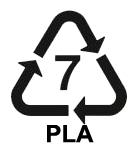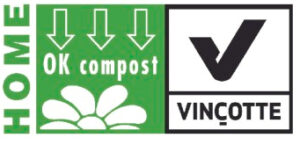Is biodegradable plastic compostable plastic?
(NOTE: You might also like this more recent post about #7 PLA plastics.)
The plastics industry has been working at a fevered pace to develop new resins with environmental benefits. Older polymers can have degradation rates spanning 1,000 years or more.
Recycling traditional resins has long been a part of the waste management landscape. But the introduction of various “degradable” resins is relatively recent.
Only 9 percent of the 32 million tons of plastic waste generated in the U.S. in 2012 was recovered for recycling. Obviously, there is plenty of room for improvement. (FACTOID: 32 million tons is equal to 1,218,208,000,000 20-ounce PET water bottles.)
Much of the industrial world is pushing toward zero waste goals. Manufacturers have designed resins that disintegrate over a more reasonable period time. They need exposure to light, oxygen and/or other degradation catalysts.
- Among the offered benefits are —
- Lower energy requirements during manufacture,
- The ability to recycle the plastic as a composting feedstock, and/or
- Properties that allow the resin to break down in landfills or natural environments.
But products carry a multitude of labels with “degradable” claims. How is the average consumer supposed to figure out what to buy? What goes where when sorting for recycling?
If the package says the plastic is “degradable” or “biodegradable,” is it compostable?
Look for the labels

The international coding system currently used for plastic products identification is less than ideal. It was originally designed for the plastics industry, not consumers. Codes are often hard to find and barely legible, and when it comes to compostable plastics — confusing.
As most folks know, plastics carry various recycling symbols to indicate resin type. For compostable plastics, look for the No. 7 symbol inside a triangle of chasing arrows.
Unfortunately, this is a catch-all category for plastics not otherwise classified, which lumps compostables in with non-compostables like plastic lumber and safety glasses. So in addition to the No. 7, compostable plastic also carries the letters “PLA” below the No. 7.
If the plastic is marked No. 7 and “O” or “Other,” do not throw it in the compost bin.

Another label to look for is the “compostable” certification label of the U.S. Composting Council and Biodegradable Products Institute. There are multiple variations of this label in circulation. Each indicates that the plastics used meet ASTM specifications D6400 or D6868 for USCC-BPI compostable compostable products as tested and certified by ASTM International, a standards organization.
In Europe, where there are multiple certification agencies, the standard to look for is EN 13432/EN 14995, indicated by the “seedling” symbol.
Be aware that “green” is a ticket to higher sales in the marketplace. In the absence of regulations, products sometimes claim to be compostable (or otherwise degradable) without having been tested and EU compostable certified. To be sure you are purchasing a compostable plastic, look for certification from a legitimate testing agency.

But also know that some manufacturers have certified their products, but choose to design and use their own “compostable” symbols. Irish cup manufacturer Down2Earth Materials is one example.
When in doubt, check the manufacturer’s website or read fine print on packaging to see if any certifications are mentioned.
‘Compostable’ may not be right for home systems
Vincotte OK home compostable logoFFor the home composter, few compostable plastics are appropriate for the backyard compost pile. In truth, the composting methods used by most municipal and commercial facilities can’t handle “compostable” plastics, either. Of the nearly 5,000 composting facilities in the U.S., only a handful utilize the robust, high-rate technologies required.

Generally, an industrial composting facility is needed to successfully compost these industrial resins.
The U.S. Composting Council has model legislation for states to use in developing regulations governing labeling and certification for compostable plastics. This document may be viewed/downloaded from the Council’s Compostable Plastics Task Force page. It includes a special label to indicate suitability for home composting.
The “OK Home” label and certification is already in use in Europe. It indicates products that can compost at the lower temperatures common to backyard composting environments. The certification entity, Vinçotte, has been verifying compostables since 1995.
Biodegradable vs. compostable
A rock may “degrade,” but it’s not compostable. A plastic may be “compostable,” but it won’t biodegrade in water or soil. When it comes to the semantics of the plastics business, the use of specific words or terms printed on labels may not be generic or interchangeable.
Terms don’t always conform to industry standards. Product claims may not result from testing and certification. To ensure you’re paying for the right product, look for a legitimate “compostable” label and certification.
- If you are uncertain as to the compostability of the plastic —
- If your locale is not serviced by a facility that can process compostables —
- If the plastic is not certified for your home compost bin —
then a more traditional plastic that can be recycled in your community might be the better choice. It’s better to recycle a traditional plastic than landfill a compostable plastic.
BTW — never toss a compostable or other bio-plastic in with recyclable plastics. Even small amounts of these resins can foul an entire processing batch for your local recycler. When in doubt about which products to buy or how to recycle them, contact your local recycling coordinator.
Recommended articles
-
Photo © iStockphoto.com/baona REPUBLISH July 16, 2019 — Have you ever stood in front of a supermarket shelf and wondered if you should buy that product made from bioplastics rather than the conventional kind? Many people assume all bioplastics are made from plants and can break down completely in the environment. But that’s not the case. The term “bioplastics” is actually used for two separate things: bio-based plastics (plastics made at least partly from biological matter) and biodegradable plastics (plastics that can be completely broken down by microbes in a reasonable timeframe, given specific conditions). Not all bio-based plastics are biodegradable, and not all biodegradable plastics are bio-based. And even biodegradable plastics might not biodegrade in every environment. Sounds confusing? It certainly is...
-
A worker examines plastic bottles at a recycling center in Santiago, Chile. MARTIN BERNETTI/AFP VIA GETTY IMAGES Bioplastics are being touted by industry marketers as the solution to plastics pollution. But the idea that bottles and packaging made of plant-based material can simply be discarded and then break down and disappear is false – recycling and reuse are the only strategies that can work. Coca-Cola calls it the PlantBottle — a new kind of recyclable plastic container, 30 percent of which is made from sugar cane and other plants, with the remaining 70 percent made from traditional oil-based plastic. The company says that PlantBottle packaging now accounts for nearly a third of its North American bottle volume and seven percent globally. Does the PlantBottle mean the giant soft drink company has crack...
-
Today, there is a bioplastic alternative for almost every conventional plastic material and corresponding application. Bioplastics – plastics that are biobased, biodegradable, or both – have the same properties as conventional plastics and, in many cases, even offer additional advantages. This includes a reduced carbon footprint or additional waste management options, such as composting. Bioplastics are an essential part of the bioeconomy and a fast-growing, innovative industry that has the potential to decouple economic growth from resource depletion and environmental impact. Bioplastics are a diverse family of materials with differing properties. There are three main groups: Bio-based or partially bio-based non-biodegradable plastics, such as bio-based PE, PP, or PET (so-called drop-ins) and bio-based technical performance polymers, such as PTT or TPC-E...




